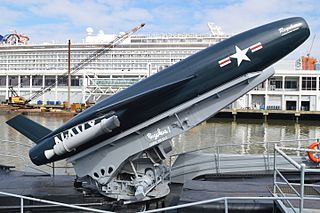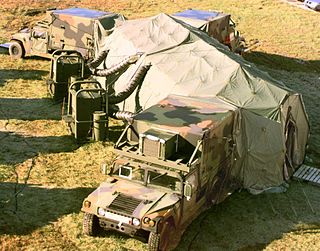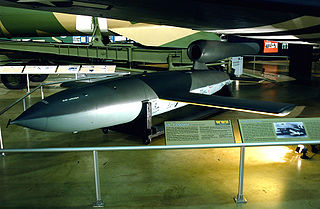
The V-1 flying bomb was an early cruise missile. Its official Reich Aviation Ministry (RLM) designation was Fieseler Fi 103 and its suggestive name was Höllenhund (hellhound). It was also known to the Allies as the buzz bomb or doodlebug and in Germany as Kirschkern or Maikäfer (maybug).

The SSM-N-8A Regulus or the Regulus I was a United States Navy-developed ship-and-submarine-launched, nuclear-capable turbojet-powered second generation cruise missile, deployed from 1955 to 1964. Its development was an outgrowth of U.S. Navy tests conducted with the German V-1 missile at Naval Air Station Point Mugu in California. Its barrel-shaped fuselage resembled that of numerous fighter aircraft designs of the era, but without a cockpit. Test articles of the Regulus were equipped with landing gear and could take off and land like an airplane. When the missiles were deployed they were launched from a rail launcher, and equipped with a pair of Aerojet JATO bottles on the aft end of the fuselage.

In military tactics, close air support (CAS) is defined as aerial warfare actions—often air-to-ground actions such as strafes or airstrikes—by military aircraft against hostile targets in close proximity to friendly forces. A form of fire support, CAS requires detailed integration of each air mission with fire and movement of all forces involved. CAS may be conducted using aerial bombs, glide bombs, missiles, rockets, autocannons, machine guns, and even directed-energy weapons such as lasers.

Pacific Missile Test Center (PMTC) is the former name of the current Naval Air Warfare Center, Weapons Division. The name of the center was the Naval Air Missile Test Center prior to PMTC. It is located at Naval Base Ventura County/Naval Air Station Point Mugu in Ventura County, California. The nearest city to the installation is Oxnard.
Ivan Alexander Getting was an American physicist and electrical engineer, credited with the development of the Global Positioning System (GPS). He was the co-leader of the research group which developed the SCR-584, an automatic microwave tracking fire-control system, which enabled M9 Gun Director directed anti-aircraft guns to destroy a significant percentage of the German V-1 flying bombs launched against London late in the Second World War.

The Martin MGM-1 Matador was the first operational surface-to-surface cruise missile designed and built by the United States. It was developed after World War II, drawing upon their wartime experience with creating the Republic-Ford JB-2, a copy of the German V-1. The Matador was similar in concept to the V-1, but it included a radio command that allowed in-flight course corrections. This allowed accuracy to be maintained over greatly extended ranges of just under 1000 km. To allow these ranges, the Matador was powered by a small turbojet engine in place of the V-1's much less efficient pulsejet.

The Direct Air Support Center (DASC) is the principal United States Marine Corps aviation command and control system and the air control agency responsible for the direction of air operations directly supporting ground forces. It functions in a decentralized mode of operation, but is directly supervised by the Marine Tactical Air Command Center (TACC) or the Navy Tactical Air Control Center (NTACC). During amphibious or expeditionary operations, the DASC is normally the first Marine Air Command and Control System (MACCS) agency ashore and is usually categorized as the Ground Combat Element's (GCE's) senior Fire Support Coordination Center (FSCC). The DASC's parent unit is the Marine Air Support Squadron (MASS) of the Marine Air Control Group (MACG).

The SCR-584 was an automatic-tracking microwave radar developed by the MIT Radiation Laboratory during World War II. It was one of the most advanced ground-based radars of its era, and became one of the primary gun laying radars used worldwide well into the 1950s. A trailer-mounted mobile version was the SCR-784.
Ground-directed bombing (GDB) is a military tactic for airstrikes by ground-attack aircraft, strategic bombers, and other equipped air vehicles under command guidance from aviation ground support equipment and/or ground personnel. Often used in poor weather and at night, the tactic was superseded by an airborne computer predicting unguided bomb impact from data provided by precision avionics Equipment for radar GDB generally included a combination ground radar/computer/communication system and aircraft avionics for processing radioed commands.
Operation Diver was the British codename for countermeasures against the V-1 flying bomb campaign launched by the German Luftwaffe in 1944 against London and other parts of Britain. Diver was the codename for the V-1, against which the defence consisted of anti-aircraft guns, barrage balloons and fighter aircraft.

The Republic-Ford JB-2, also known as the Thunderbug, KGW and LTV-N-2 Loon, was a United States copy of the German V-1 flying bomb. Developed in 1944, and planned to be used in the United States invasion of Japan, the JB-2 was never used in combat. It was the most successful of the United States Army Air Forces Jet Bomb (JB) projects during World War II. Postwar, the JB-2 played a significant role in the development of more advanced surface-to-surface tactical missile systems such as the MGM-1 Matador and later MGM-13 Mace.

Lee L. Davenport was an American physicist. He was a member of the MIT Radiation Laboratory during World War II, responsible for the development and deployment of the SCR-584 radar system.
Combat Skyspot was the ground-directed bombing (GDB) operation of the Vietnam War by the United States Air Force using Bomb Directing Centrals and by the United States Marine Corps using Course Directing Centrals. Combat Skyspot's command guidance of B-52s and tactical fighters and bombers—"chiefly flown by F-100's"—at night and poor weather was used for aerial bombing of strategic, close air support, interdiction, and other targets. Using a combination radar/computer/communications system at operating location in Southeast Asia, a typical bombing mission had an air command post turn over control of the mission to the radar station, and the station provided bomb run corrections and designated when to release bombs.
The AN/MPQ-2 Close Cooperation Control Unit was a truck-mounted pautomatic tracking radar/computer/communication system for aircraft command guidance, e.g., missile tracking, and for Radar Bomb Scoring. It was introduced shortly after the end of World War II. For ground directed bombing (GDB), an operator would manually plot a target on the "Blind Bombing Plotting Sheet", then use the manual "E6B computer and bombing tables" to plot the release point for striking the target, after which a radar operator used the AN/MPQ-2 to acquire a track of the bomber near an initial point during which allowed ground control of the bomb run to the release point.
The Western Electric M-33 Antiaircraft Fire Control System was an X-Band "Gunfire Control Radar", for aiming antiaircraft artillery by computer control. Developed for mobility via 3 trailers, the "M-33 system could compute, for the 90-mm. and 120-mm. guns, firing data for targets with speeds up to 1,000 mph", and for targets at 120,000 yards had similar gun laying accuracy as "SCR-584 type radars" at 70,000 yards. The system included a telescopic "target selector" on a tripod near the guns for additional measurement of aircraft "azimuth and elevation data [to] be transmitted to the computer and utilized as gun directing data."
Matador Automatic Radar Control (MARC) was a command guidance system for the Martin MGM-1 Matador ground launched cruise missile that used combination radar/computer/communication centrals for ground-directed bombing. As for the earlier ground central used with the X-10 aircraft,* MARC had an "Air Link" from the ground for control and an airborne AN/APW-11A radar transponder on the missile for ranging. A series of "MSQ sites". each with a mobile AN/MSQ-1A central in 3 vans had an automatic tracking radar to geolocate the Matador up to ~600 nmi. MARC provided command guidance during the "mid-course phase" after Matador/MARC contact was established following the missile launch off the Zero Length Launcher and until an MSQ transmitted the dive ("dump") command to start the flight path toward the target. Originating in the Caltech/Martin "ZEL Project" and developed as part of weapon system "Project MX 771" at the "Air Force Missile Test Center, Cocoa, Florida"; MARC had accuracy at "crossover into enemy territory" of ~500 ft (150 m) and—at an AN/MSQ-1A range of 165 nautical miles —a CEP of 2,700 ft (820 m).
Pilotless Bomber Squadron may refer to various military units for unmanned aerial vehicles (drones):
The Reeves AN/MSQ-1 Close Support Control Set produced by Reeves Instrument Corporation was a trailer-mounted combination radar/computer/communication developed under a Rome Air Development Center program office for Cold War command guidance of manned aircraft Developed for Korean War ground-directed bombing, one detachment of the 3903rd Radar Bomb Scoring Squadron bombed itself with an MSQ-1 because it mistakenly used procedures for the earlier SCR-584/OA-294 system The MSQ-1 was subsequently used for nuclear testing during Operation Teapot, and for aircraft tests such as for "MSQ-1 controlled pinpoint photography" in 1954.

The PTV-N-2 Gorgon IV was a subsonic ramjet-powered missile developed by the Glenn L. Martin Company for the United States Navy. Originally intended as an air-to-surface weapon, it materialized as a propulsion test vehicle, and between 1947 and 1950 was used for test purposes and, as the KDM Plover, as a target drone.

The General Electric AN/TPQ-1O Course Directing Central was a light-weight, two-unit, helicopter transportable, ground based bombing system developed for use by the United States Marine Corps to provide highly accurate, day/night all weather close air support. This self-contained system was designed to guide an aircraft, equipped with the proper control equipment, to a release point for accurate all-weather delivery of ordnance and supplies to a preselected target. The AN/TPQ-10 and its operators were known as an ‘’Air Support Radar Team’’ (ASRT) and were employed by the Marine Air Support Squadrons within the Aviation Combat Element.










